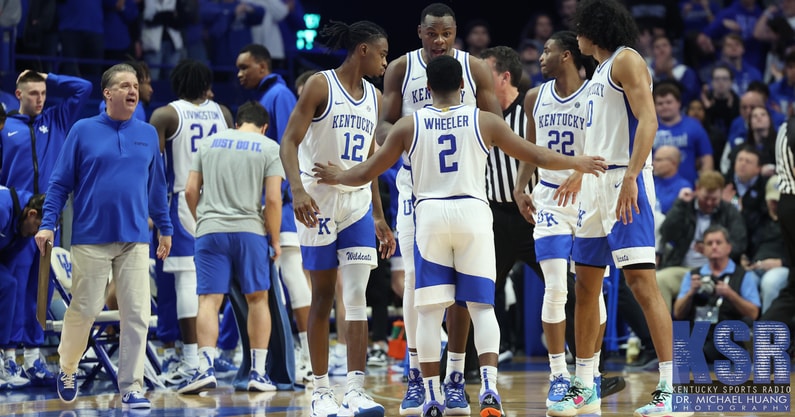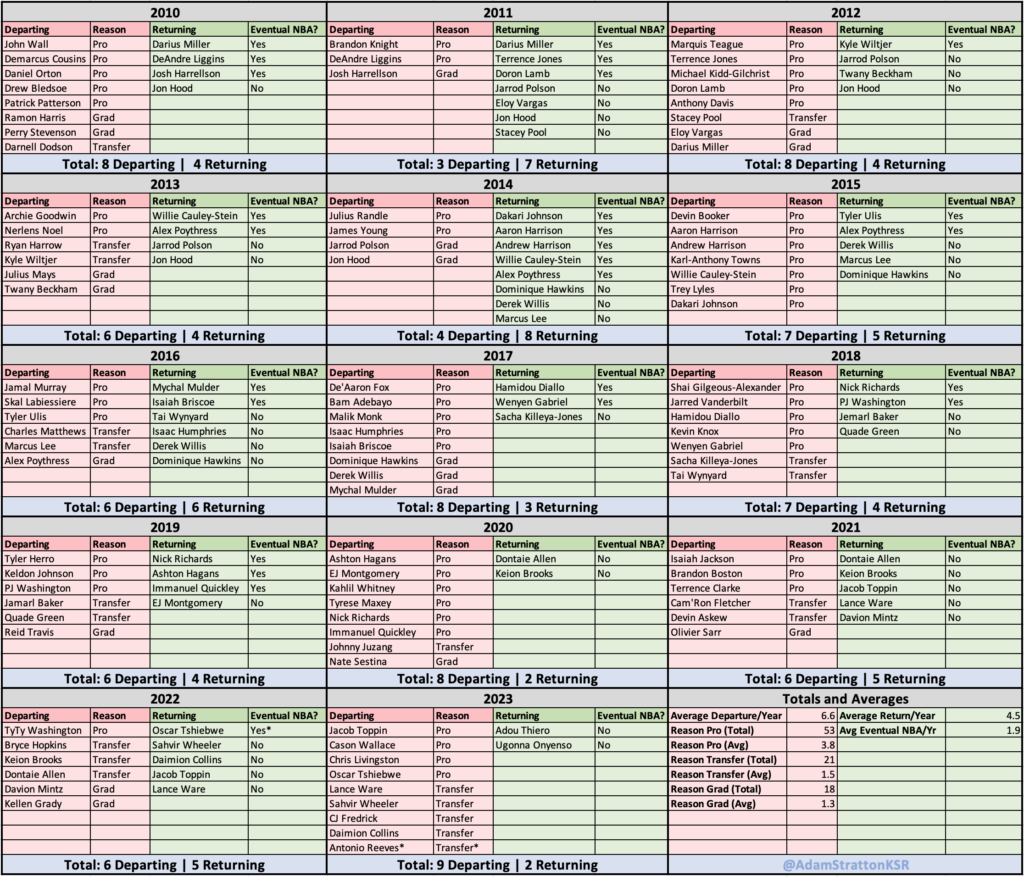Analyzing Kentucky's roster turnover during the Calipari era

High roster turnover during the Calipari era at Kentucky is nothing new. In fact, Cal’s ability to reload year after year is kind of his thing. For some traditionalists within Big Blue Nation, this has been more of a bug than a feature, as they claim they prefer four-year players over one-and-done prospects. Personally, I think these folks just prefer to cheer for their favorite players for more than one season and grow tired of having to learn new ones to love each passing year.
Of course, winning cures all ailments, and during Cal’s first decade in Lexington, there was a lot of healing taking place. Recently, however, the bruises are not fading away as quickly as they used to.
With a roster still in flux further into the offseason than ever before, I thought it might be useful to compare this round of player departures and returns to every other year during Cal’s tenure. The findings were not a huge surprise, but when you lay it all out, reasons for recent struggles and past glory begin to crystalize.
The Data: Kentucky’s stay-or-go decisions for the last 14 years
I evaluated the roster of every team since John Calipri’s first year as head coach, focusing just on the scholarship players. I excluded first-year redshirts, walk-ons (even those who earned a courtesy scholarship), and guys who never played a game (i.e. Enes Kanter and Shaedon Sharpe) as their stay-or-go decisions were moot.
The year noted in the table represents the corresponding offseason and what each player decided to do, whether that was to return to Kentucky or leave for either the pros, another school, or graduation.
The one wildcard for this season is, of course, Antonio Reeves, who has yet to make a final decision. If the rumors are to be believed, he is leaning toward a transfer, so I marked it as such on this spreadsheet. I will gladly rush to correct this if he decides to come back to Kentucky.

Numbers at a Glance
Kentucky has averaged 6.6 scholarship player departures per offseason since 2010. I do not have the totals for other schools, but I’m going to go out on a limb and say that very well could lead the nation. The fewest came after the 2011 season when just three scholarship players left the program (DeAndre Liggins, Brandon Knight, and Josh Harrellson).
The most departures? You guessed it. It’s right now in 2023, as nine players (if we include Antonio Reeves) have walked out the door. That is 36% higher than average.
Most of the time when players leave, it is for the pros. I am generalizing to just say pros and not NBA because we’ve had a few not quite make it to the League or simply choose to play professionally abroad.
3.8 Kentucky players per year have bolted for the professional ranks since Cal arrived. Transferring is the next most popular reason to leave at 1.5 players per year, just slightly ahead of graduating at 1.3 per year.
Having more transfers than graduates among scholarship players is not the most endearing stat, but to be fair, the transfer portal has skewed those numbers a bit in the last few years. You have probably already beaten me to this, but this year had the highest number of transfers, with five taking their talents to another university (again, including Reeves).
Similarly, the extra Covid year that everyone received but has not necessarily taken advantage of, also adjusted the graduation numbers down because even if they graduated, I counted them as leaving for the pros if they had eligibility remaining.
The lowkey indicator of team success
Calipari made a name for himself in recruiting the best freshmen available. John Wall, Anthony Davis, and Karl-Anthony Towns, or future No. 1 overall picks in the NBA in general, bode well for a team’s win column. However, there is another stat that jumps out as a key indicator of Kentucky’s success: the number of returning players who eventually play in the NBA.
Kentucky has averaged 1.9 returning players per year who eventually played at least one game in the League over the last 14 years, a number that has dipped recently.
Top 10
- 1Breaking
Johni Broome
Auburn star leaves game vs. Michigan State
- 2New
Final Four game times
Tip times, TV announced
- 3Hot
Baseball Top 25 projection
More shakeup coming
- 4
Houston vs. Duke odds
Final Four line goes up during Houston vs. UT
- 5
Jay Bilas calls out
Reaction to Willard hiring
Get the On3 Top 10 to your inbox every morning
By clicking "Subscribe to Newsletter", I agree to On3's Privacy Notice, Terms, and use of my personal information described therein.
Prior to 2020, every team with the exception of the 2013 team rostered at least two returning players who played at least one game in the NBA. In 2013, the only player who met this qualification was Kyle Wiltjer and you may remember the result of that season was an early exit from the NIT. All the teams with two or more had a solid year.
Kentucky’s near undefeated season in 2015 featured a whopping five future NBA guys who came back from 2014. The next two highest were the 2011 Final Four team and the 2012 championship team when three such players stayed from the season prior.
Not surprisingly, this has not been the case in the last few years. In fact, Oscar Tshiebwe is the only player since the 2020 offseason who has returned that will (probably) play in the NBA, even though he likely won’t be drafted.
Counting next year’s squad, that is five consecutive seasons where Kentucky won’t have an NBA-caliber college veteran on the team who knows their way around campus. Compare that to the 10 previous seasons which featured an average of 2.5 players per year in this category and you see how much of a difference having non-freshman NBA-bound players matters.
Where to go from here
Typically, the purpose of analyzing data is to make a sound judgment about what to do moving forward. Unfortunately, Getting more NBA-caliber players to come back for a second season is much easier said than done. At this rate, getting guys to come back regardless of their NBA future is a struggle.
For this upcoming season, not only does Kentucky have the most players leaving in the Cal era, but they also have the fewest returning. Moreover, Kentucky’s sole two returners, Adou Thiero and Ugonna Onenyso, are not currently highly coveted NBA prospects (though, I hope they prove everyone wrong and evolve into that).
With potentially eight freshmen coming in, Kentucky will have to break the mold that has given them success in the past if they plan to go far in March.
Looking further ahead, especially considering a 2024 High School recruiting class that experts consider weak, Kentucky will need to keep one of these highly-touted freshmen who might not be a lottery pick quite yet to stick around for another season. In theory, NIL should help this cause, but that has not panned out thus far. The lure of the transfer portal has beaten out potential endorsement deals at Kentucky.
The bottom line is that Kentucky has its work cut out for them when it comes to roster building. Yes, the No. 1 recruiting class in the nation helps (a lot), but NIL and the transfer portal have disrupted college basketball. Recruiting top-notch players to return is just as important as recruiting new ones to join.









Discuss This Article
Comments have moved.
Join the conversation and talk about this article and all things Kentucky Sports in the new KSR Message Board.
KSBoard